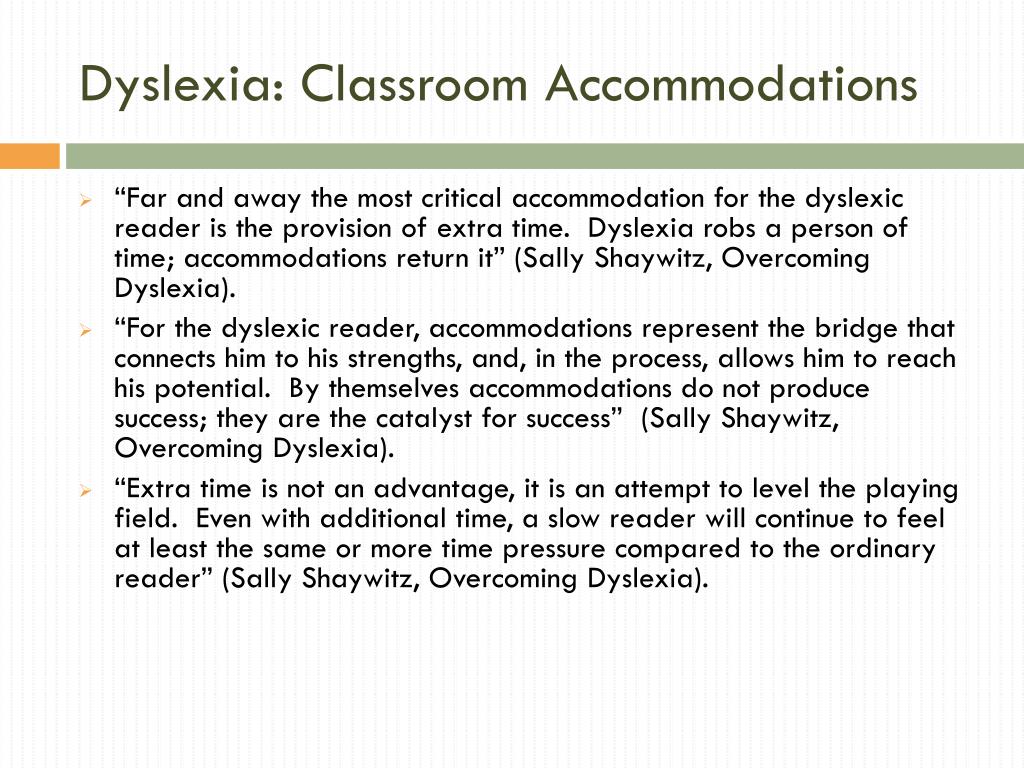

Proponents of universal screening for dyslexia in the early grades argue that it helps curb the need for interventions for students later in school, and research supports this claim.ĮdWeek reporter Elizabeth Heubeck recently wrote about researchers’ findings that “arly identification of struggling readers and subsequent prevention programs can reduce by up to 70 percent the number of children placed in special education … nterventions for struggling readers that start in 4th grade take four times longer than those that start in late kindergarten.”Ĭommenters seconded the importance of universal screening for dyslexia in the early grades as a pillar of support for dyslexic students. Advocate for universal dyslexia screening

#Dyslexia accommodations how to
Let them use speech to text to get their ideas down without having to try to struggle how to spell words, read aloud text to them, let them use spell check & word prediction software.” “Make learning to decode words as multi-sensory as possible to activate more areas of the brain.

Prioritize early literacy as a school/system to ensure kids with dyslexia have access to the instruction they need to achieve literacy in the early grades.” Advocate for early screening and intervention. “Learn about the science of reading and how instruction and practice aligned to the body of evidence can make a huge difference for those with dyslexia. The literacy movement has been bolstered by parents of children with dyslexia, who advocate for explicit instruction in phonics, noting that the practice-while crucial for dyslexic students-helps all children learn to read.ĮdWeek’s social media followers echoed their support for this approach in helping dyslexic students. More than half the states now mandate a “science of reading” approach to early literacy. Eventually, teachers help students weave these skills together like strands in a rope, allowing them to read more complex texts,” Sarah wrote last July.
#Dyslexia accommodations crack
While learn how to crack the code, are also introduced to rich stories and texts that build their background knowledge. “In brief, the science of reading embraces the systematic, explicit teaching of sounds and letters. Employ the ‘science of reading’Įducation Week reporter Sarah Schwartz has extensively covered the “science of reading” movement, which pushes for the implementation of an evidence-backed approach to teaching kids how to read. “Have teachers understand the term dyslexia is an umbrella that could mean central auditory processing issues, visual discrimination issues, depth perception issues and then have access to diagnostic tests to identify which one student is dealing with and strategies to support students dependent on their learning disability.” As my child got older, she took over this role.” “Implement curriculum in college to teachers to learn what dyslexia is and is not! It’s very frustrating as a parent, teaching teachers what dyslexia is and how they can help my child. After all, how can students understand their condition if their teachers and schools do not understand it?” wrote 5th grade teacher Kyle Redford in a 2016 Education Week Opinion essay.Ĭommenters pointed to better teacher training on working with dyslexic students as a foundation to support them.

“e need to make sure that all teachers understand the way dyslexia works what it impacts and what it does not. Not all teachers are well equipped to help these students, commenters said. More training for teachersĮstimates suggest about 3 percent to 7 percent of the population have dyslexia. We broke down their responses into five main themes. We asked our social media followers on Twitter, Facebook, and LinkedIn what teachers can do to support their students with dyslexia. Children with dyslexia typically struggle to relate sounds to letters and words, interfering with how they “decode,” or lift words off the page when reading. Dyslexia is a processing disorder that hinders children’s ability to read.


 0 kommentar(er)
0 kommentar(er)
